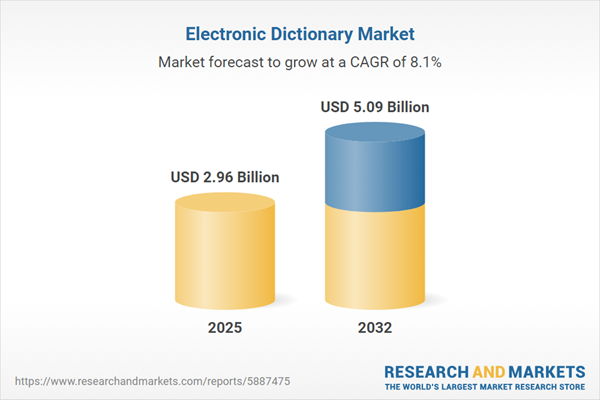Speak directly to the analyst to clarify any post sales queries you may have.
The electronic dictionary market is reshaping how organizations manage language workflows, enabling enterprises to streamline multilingual operations and quickly adapt to global business shifts through reliable digital platforms.
Market Snapshot: Electronic Dictionary Market Size and Growth
The electronic dictionary market reached USD 2.73 billion in 2024 and is forecast to expand to USD 2.96 billion by 2025, achieving a compound annual growth rate (CAGR) of 8.06% through 2032. This steady growth is driven by ongoing adoption of digital language solutions within commercial and educational sectors. As organizations integrate these tools, they gain enhanced capabilities for communication, cross-functional collaboration, and operational agility. Decision-makers increasingly view these platforms as strategic for maintaining seamless workflows and rapid response to evolving business conditions.
Scope & Segmentation of the Electronic Dictionary Market
This report provides actionable insights tailored for executive planning, detailing the main segments and current trends shaping technology adoption. Understanding these factors supports proactive investment allocation and operational alignment in a transforming digital language landscape.
- Formats: Handheld devices, web-based platforms, and mobile applications designed with enterprise security and scalability in mind, supporting professional teams and project-based workflows.
- End Users: Enterprise professionals, educational institutions, and business travelers benefit from advanced translation and language management tools to address diverse communication needs across organizations and sectors.
- Distribution Channels: Digital delivery models, including mobile integrations and integrated hardware-software packages, facilitate procurement strategies ranging from startups to multinational corporations and support seamless technology rollout.
- Technology Solutions: Cloud-based services, SaaS options, API integrations, and offline features ensure uninterrupted access to critical language resources, regardless of connectivity or working environment.
- Applications: Educational deployments, sector-driven terminology management, and workflow optimization empower distributed teams to navigate region-specific and industry-based language challenges.
- Pricing Models: Options such as freemium, subscription, and perpetual licensing allow organizations to balance immediate language requirements with longer-term technology planning and cost structures.
- Regions Analyzed: Americas, Europe, Middle East and Africa, and Asia-Pacific, each with distinct language needs, compliance requirements, and adoption trajectories, influencing overall deployment and localization strategies.
- Companies Covered: Casio Computer Co., Ltd.; Sharp Corporation; Franklin Electronic Publishers; Ectaco, Inc.; Seiko Instruments Inc.; Kingstone Technology Co., Ltd.; Fujitsu Limited; Lingvo Ltd.; Babylon Software Ltd.; and VoxWare, Inc., each recognized for product innovation and international presence within the digital language market.
Key Takeaways for Senior Decision-Makers
- Cloud-native and AI-supported electronic dictionary platforms offer flexible language management, advancing workforce mobility and consistent communication for both remote and on-premises teams.
- Customizable hardware and software modules ensure seamless language access in hybrid work scenarios, contributing to improved business resilience and continuity.
- Strategic collaborations with language solution providers and specialists help tailor system configurations, addressing operational complexity and varied compliance needs across regions.
- Adaptive pricing models and phased deployments enable effective resource management, supporting organizations as they scale or respond to financial constraints.
- Comprehensive localization and compliance support helps organizations navigate diverse regulatory standards, enhancing engagement in both local and global markets.
- API connectivity optimizes workflows by integrating language tools with existing IT systems, facilitating operational adaptation as enterprise needs evolve.
Tariff Impact: Navigating Regulatory and Supply Chain Dynamics
Changes in U.S. tariffs have heightened the focus on supply chain resilience for electronic dictionary providers. Diversifying sourcing strategies and leveraging subscription-based models, including API licensing, has strengthened organizational risk management. For enterprises, adopting digital-first and hybrid deployment approaches helps ensure business stability and enables rapid adaptation as global regulatory and supply chain conditions change.
Methodology & Data Sources
This study synthesizes insights from interviews with senior executives, sector-focused research, academic literature, and validated public data. Industry expert review was utilized to maximize relevance and accuracy for strategic use in the electronic dictionary market.
Why This Report Matters
- Enables leaders to effectively integrate language technology, enhancing organizational communication and supporting decisive strategy execution.
- Equips executives with frameworks to address regulatory risks and optimize supply chain management for greater operational flexibility.
- Reveals market shifts and technology trends in digital language solutions, enabling more proactive planning and opportunity identification within a competitive environment.
Conclusion
Adopting electronic dictionary solutions empowers organizations to strengthen communication, improve operational adaptability, and align teams with ongoing business evolution.
Additional Product Information:
- Purchase of this report includes 1 year online access with quarterly updates.
- This report can be updated on request. Please contact our Customer Experience team using the Ask a Question widget on our website.
Table of Contents
3. Executive Summary
4. Market Overview
7. Cumulative Impact of Artificial Intelligence 2025
Companies Mentioned
The companies profiled in this Electronic Dictionary market report include:- Casio Computer Co., Ltd.
- Sharp Corporation
- Franklin Electronic Publishers, Inc.
- Ectaco, Inc.
- Seiko Instruments Inc.
- Kingstone Technology Co., Ltd.
- Fujitsu Limited
- Lingvo Ltd.
- Babylon Software Ltd.
- VoxWare, Inc.
Table Information
| Report Attribute | Details |
|---|---|
| No. of Pages | 184 |
| Published | November 2025 |
| Forecast Period | 2025 - 2032 |
| Estimated Market Value ( USD | $ 2.96 Billion |
| Forecasted Market Value ( USD | $ 5.09 Billion |
| Compound Annual Growth Rate | 8.0% |
| Regions Covered | Global |
| No. of Companies Mentioned | 11 |









